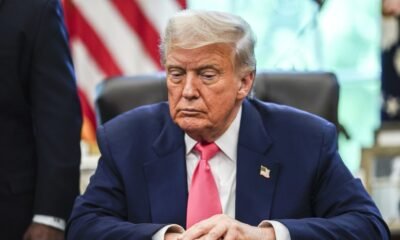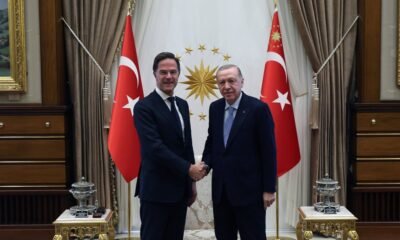Economy
What will Zangezur Corridor, new South Caucasus route, mean for Türkiye?
Türkiye is on the brink of a new era in logistics and foreign trade, as a recent peace deal between Azerbaijan and Armenia is set to open a strategic transit corridor through the South Caucasus.
The Zangezur Corridor that passes through Armenia and links the bulk of Azerbaijan’s territory to its Nakhchivan exclave that borders Türkiye is a key part of the agreement signed at a trilateral summit hosted by U.S. President Donald Trump last week.
The summit saw Azerbaijani President Ilham Aliyev and Armenian Prime Minister Nikol Pashinyan sign a joint declaration aimed at ending decades of conflict.
Under the deal, the United States will have the development rights of the proposed route, dubbed the “Trump Route for International Peace and Prosperity,” which passes near the Iranian border. Tehran has said it would not accept that.
Baku and Yerevan have been at odds since the late 1980s, when Nagorno-Karabakh, a mountainous Azerbaijani region, was occupied by Armenia-backed armed separatists. Azerbaijan took back full control of the region in 2023, and some 100,000 Armenians in the enclave returned to Armenia.
Peace negotiations had been underway for nearly two years, with no sign of progress, until the White House stepped in.
The Zangezur Corridor will connect Azerbaijan and its Nakhchivan exclave, which are separated by a 32-kilometer-wide (20-mile-wide) patch of Armenian territory.
For Azerbaijan, a major producer of oil and gas, the route also provides a more direct link to Türkiye and onward to Europe. The corridor is expected to eventually include a rail line, oil and gas pipelines and fiber optic lines.
Strategic opportunity in Eurasian logistics
The route is not only a transportation project, but a strategic initiative poised to reshape regional trade routes, logistics networks and geopolitical balances, according to to Bilgehan Engin, head of the Turkish Forwarding and Logistics Association (UTIKAD).
The route, dubbed the “Trump Route for International Peace and Prosperity,” is now being viewed as a critical opportunity for Türkiye’s regional logistics and trade strategies.
Experts suggest the corridor could offer Türkiye new integration pathways in energy, transportation and digital infrastructure. With railways, oil and gas pipelines and fiber-optic networks planned along the route, Türkiye could emerge as a regional gateway for energy and communications.
Analysts note that the corridor could enhance Türkiye’s competitive edge in logistics, especially through its ports in Istanbul and southern Mersin province, which serve as key gateways to European markets. When integrated with the Middle Corridor’s Baku-Tbilisi-Kars railway, Zangezur could significantly reduce both transportation costs and delivery times.
“Türkiye has the opportunity to become a central actor in global supply chains by establishing a logistics bridge between East and West,” UTIKAD’s Engin said.
Complementary route to Middle Corridor
He explained that the Zangezur Corridor offers an alternative and complementary route to the Middle Corridor, which stretches from China across the Caspian Sea to Azerbaijan, Georgia, Türkiye and onward to Europe.
“Due to infrastructure limitations and customs bottlenecks in Georgia, transit times have been prolonged. The Zangezur route could substantially reduce these delays,” he noted.
With the new route, Türkiye would establish direct land and rail connections to Central Asia via Nakhchivan and Azerbaijan, according to Engin. “Transit times will be shortened, logistics costs reduced and uninterrupted links with Turkic republics will be established. This will also create new economic opportunities for eastern provinces in Türkiye,” he noted.
UTIKAD believes the corridor will add not only commercial value but also geoeconomic significance to Türkiye. Integrated with the planned Kars-Iğdır-Nakhchivan railway, it could open new trade routes and development prospects for eastern regions.
“This corridor will not only strengthen Türkiye’s central position in Eurasia, but also serve as a means for the Turkic world to come closer economically and culturally,” said Engin.
Geopolitical risks
Potential U.S. involvement in managing the corridor could accelerate its operationalization, particularly through modernization of ports, railways, security systems and customs infrastructure, Engin says.
“This could fast-track Türkiye’s ambition of becoming a regional logistics hub,” he added.
However, he also warned of geopolitical risks.
“U.S. influence over the corridor could threaten China’s trade security and provoke countermeasures. It could also reduce Russia’s influence in the South Caucasus and lead to political pressures that may limit Türkiye’s logistics leadership,” Engin said.
He stressed the need for Türkiye to manage the process with both geopolitical and geoeconomic sensitivity, maintaining strategic autonomy while pursuing a balanced policy aligned with regional dynamics.
Economy
Analysts weigh risks as Trump slams Goldman on tariff forecasts
U.S. President Donald Trump’s criticism of Goldman Sachs’ research on tariff risks could prompt some analysts to water down their research, investors and academics said, an outcome that could leave investors with less reliable information. The reams of research that banks such as Goldman produce are used by institutional investors, such as hedge funds and asset managers, in deciding how to allocate capital.
Trump’s comments – in which he lambasted Goldman, its economics team and CEO David Solomon and accused them of making “a bad prediction” – have triggered a debate on Wall Street about the possible fallout, according to interviews with banking industry sources and investors. At one Wall Street bank, Trump’s comments spurred informal conversations among staff, a source familiar with the matter said. The source said they also discussed how to incorporate government data in the wake of Trump’s decision to fire the head of BLS, claiming – without evidence – that its data had been politicized. Still, the bank was not considering changing the way research operates. “This is going to come down to a person’s ability to withstand a barrage of criticism from the Oval Office, and the extent to which these banks provide support for their chief economists,” said Dave Rosenberg of Rosenberg Research, who has worked in the economics departments at several banks. “If we notice that research is being watered down … then we’ll know that this has had an effect.”
Jack Ablin, chief investment strategist at Cresset Capital, said if banks do start self-censoring, smaller investors who do not have the resources to do their own analysis are likely to suffer most. Trump’s criticism is his latest attack on corporate America and other institutions, and is a break from historical norms, where presidents have typically avoided calling out private companies and executives for things they do not like.
Some companies that have considered passing on tariff costs to customers have faced public criticism, and Trump, who came to politics after running businesses, has intervened directly in private business decisions by making a deal with Nvidia to give a portion of its revenues from sales to China of AI chips to the government. Trump “certainly is taking a number of steps that diverge from the traditional view of the respective roles of the government and private industry,” said Henry Hu, a securities law professor at the University of Texas.
In a social media post earlier this week, Trump said foreign companies and governments were mostly absorbing the cost of his tariffs, counter to Goldman’s research. “Given that sell-side Wall Street analyst predictions have been about as accurate as random guessing, small investors will do just fine with the president exercising his First Amendment right about flawed Wall Street research,” a White House official told Reuters. On Wednesday, Goldman’s U.S. head economist David Mericle defended its research on CNBC, vowing to “keep doing” what the bank considers informative research.
Goldman declined requests for further comment. Other major banks, including Wells Fargo, JPMorgan, Morgan Stanley, Deutsche Bank, Bank of America and Citigroup, declined to comment.
Reputational risks
There has already been evidence of self-censorship. A senior JPMorgan Asset Management investment strategist, Michael Cembalest, earlier this year said during a webinar that he refrained from voicing some of his thoughts on U.S. tariffs publicly. Shortly after Cembalest’s comments, Jamie Dimon, JPMorgan’s CEO, said that he expects analysts to speak their minds. Both Cembalest and the bank declined to comment for this story.
Hu said there is a risk involved in even appearing to give way to political pressure.
“Goldman’s reputational capital is at stake here,” he said. “If their views on the economy become biased, and they are shown to be wrong, why would anyone choose Goldman to advise them on anything?”
Mike Mayo, banking analyst at Wells Fargo, said independent research is critical for investment bank’s reputation. “Investment banks live and die by their reputation and independence. That transcends all other considerations.” Wall Street research has long been tightly overseen, one source said, with supervisory analysts reviewing research reports to ensure that language is not inflammatory, emotive or partisan and that reports are objective and cite sources. That person said that if analysts feel unable to speak openly then investors will pay more or take greater risk. Liquidity will suffer and there will be less foreign participation in U.S. markets, the person said.
It was large losses by smaller investors that triggered the first major probe of Wall Street research in the aftermath of the dot com stock bubble of the late 1990s. Eliot Spitzer, then New York Attorney General, found that Wall Street analysts had swapped their honest opinions for unwarranted “buy” ratings on companies to help their banks win underwriting and advisory business. The result: a $1.5 billion global settlement payout by Wall Street and lifetime bans for some analysts.
It remains to be seen whether the current kerfuffle will have an outsized impact on Wall Street or if it is a storm in a teacup, said Steve Sosnick, market strategist at IBKR.
“It does raise a lot of questions,” he added.
Economy
Trump says to set tariffs on steel, semiconductors in coming weeks
United States will announce tariffs on imports of steel and semiconductor chips in the coming weeks, President Donald Trump said on Friday.
“I’ll be setting tariffs next week and the week after on steel and on, I would say, chips,” Trump told reporters aboard Air Force One as he headed to a meeting with Russian President Vladimir Putin in Alaska.
He said the rates would be lower at the start to allow companies to build up domestic manufacturing in the U.S., rising sharply later, following a pattern he has also outlined for tariffs on pharmaceuticals. He gave no exact rates.
“I’m going to have a rate that is going to be lower at the beginning – that gives them a chance to come in and build – and very high after a certain period of time,” he said.
Trump said he felt confident that companies would opt to manufacture in the United States, rather than face high tariffs.
Trump has upended global trade by imposing sharply higher duties on nearly all countries’ exports to the United States, along with tariffs on specific sectors, such as automotive.
Trump in February raised tariffs on steel and aluminum to a flat 25%, but he announced in May that he would double the rate to 50% to boost domestic manufacturers.
It was not immediately clear if another tariff increase on the metals was in the offing.
Trump said last week he would impose a tariff of 100% on imports of semiconductors, but companies that committed to building up manufacturing in the United States would be exempt.
His remarks were made in tandem with an announcement that Apple would be investing an additional $100 billion in its home market.
Economy
Top officials hail Türkiye’s record reserves to tout stronger stability
Treasury and Finance Minister Mehmet Şimşek and Vice President Cevdet Yılmaz say the latest macroeconomic and financial indicators point to strengthened stability, improved investor sentiment and progress toward disinflation targets.
Both officials cited Thursday’s data that showed the Central Bank of the Republic of Türkiye’s (CBRT) gross foreign exchange reserves had reached $174.4 billion (TL 7.13 trillion) as of Aug. 8, the highest level on record.
Reserves rose 3.2%, or $5.38 billion, from the previous week’s $168.99 billion. CBRT officials on Thursday said the monetary authority would maintain its reserve accumulation policy.
“While the positive cycle in financial markets is strengthening, macro-financial stability is being consolidated,” Şimşek wrote on social media platform X on Thursday.
Vice President Yılmaz highlighted that higher foreign exchange reserves help reduce the country’s risk premium, which lowers external financing costs, and supports financial stability and the disinflation process.
He also pointed out that the current account deficit remains below projected levels, reducing the need for external financing.
Yılmaz went on to comment on the central bank’s new strategy announced Thursday, which separates the targets from its inflation forecast ranges in a new system aimed at boosting transparency and confidence.
The bank kept its target for this year at 24%, even though it is forecasting inflation of between 25% and 29%. Yılmaz said technical analyses supported that range.
Previously, the bank presented the target as the midpoint of the forecast range. Separating the goal and the range could give markets a clearer indication of where policy might be heading.
“Technical analyses indicate that by the end of the year, the inflation rate will fall within the central bank’s forecast range of 25%-29%. The disinflation process will gain strength as recent developments increasingly reflect in expectations,” he wrote on social media platform NEXT Social.
A separate survey by the CBRT on Friday showed that market participants’ year-end inflation expectations rose slightly to 29.69%. That compared to the 29.66% forecast in the July survey.
In contrast, expectations for inflation in 12 months time fell to 22.84% from 23.39%. The forecast for inflation in two years time also declined, falling to 16.92% compared to the August survey’s 17.08%.
The central bank is aiming to cut inflation to 16% by the end of next year and 9% by end-2027, CBRT Governor Fatih Karahan said on Thursday.
Annual consumer price inflation fell to 33.52% in July, sustaining a downward trend after peaking at 75% in May 2024.
“In an environment where financial stability is reinforced and the decline in inflation continues, we will persist in our efforts resolutely and in coordination, in line with our goals of sustainable growth and enhancing social welfare,” Yılmaz said.
Şimşek also referenced the latest status of the foreign exchange-protected deposit scheme, a costly measure introduced to shield Turkish lira deposits from currency depreciation. Authorities began phasing it out in 2023 as part of a shift toward more conventional economic policies.
Şimşek said the stock of the scheme, known as KKM, has been declining for two consecutive years, falling by TL 3 trillion. As of Aug. 8, it stood at TL 458.5 billion, down from nearly TL 478 billion the previous week, the data from the Banking Regulation and Supervision Agency (BDDK) showed on Thursday.
This marked the fastest weekly decline in three months. The scheme had peaked at TL 3.4 trillion in August 2023.
Under the scheme, individuals and businesses were able to deposit lira in special accounts that were protected against exchange rate losses. The lira lost 44% of its value against the dollar in 2021, 29% in 2022, 37% in 2023 and 16% last year. So far this year, it has depreciated by over 13%.
Officials and the central bank have said the scheme would be terminated by the end of 2025, though many bankers believe the exit could come even sooner.
Şimşek also reported that the share of lira in total deposits has risen to 59.6%. Additionally, yields on Türkiye’s 10-year dollar-denominated bonds have dropped below 7%.
He emphasized that the government continues to “resolutely” implement its medium-term program in line with disinflation targets to bolster economic resilience.
Economy
Slumping factory output, retail sales deliver blow to Chinese economy
China’s factory output growth fell to its weakest pace in eight months in July, while retail sales slowed markedly, adding pressure on policymakers to deliver more stimulus to bolster domestic demand and shield the $19 trillion economy from external shocks.
The underwhelming indicators come as officials navigate pressure on multiple fronts ranging from U.S. President Donald Trump’s trade policies to extreme weather, excessive competition in the domestic market, and chronic weakness in the property sector.
Industrial output grew 5.7% year-over-year in July, National Bureau of Statistics (NBS) data showed on Friday, the lowest reading since November 2024, and compared with a 6.8% rise in June. It missed forecasts for a 5.9% increase in a Reuters poll.
Retail sales, a gauge of consumption, expanded 3.7% in July, the slowest pace since December 2024, and cooling from a 4.8% rise in the previous month. They missed a forecast gain of 4.6%.
A temporary trade truce reached between China and the United States in mid-May, which was extended by another 90 days this week, has prevented U.S. tariff rates on Chinese goods from returning to prohibitively high levels. However, Chinese manufacturers’ profits continue to take a hit from subdued demand and factory-gate deflation at home.
“The economy is quite reliant on government support, and the issue is those efforts were ‘front-loaded’ to the early months of 2025, and by now their impact has somewhat faded out,” said Xu Tianchen, senior economist at the Economist Intelligence Unit.
That policy support has helped the world’s second-largest economy avoid a widely anticipated sharp slowdown, along with factories taking advantage of the U.S.-China trade truce to front-load shipments, but analysts say weak demand at home and global risks will drag on growth in coming quarters.
Friday’s data drew a mixed reaction from investors, with Chinese blue chips up 0.5% and Hong Kong stocks down 1.1% in afternoon trading.
Property woes, slow GDP recovery
Fixed asset investment grew just 1.6% in the first seven months of the year from the same period last year, compared with an expected 2.7% rise. It had expanded 2.8% in the first half.
“Firms may be running on existing capacity rather than building new plants,” said Yuhan Zhang, principal economist at The Conference Board’s China Center.
“The July industrial value-add breakdown tells a more nuanced story than the weak fixed asset investment headline,” he added, pointing to China’s automobile manufacturing, railway, shipbuilding, aerospace and other transport equipment industries as “outliers (that) indicate policy-driven, high-tech and strategic sectors are still attracting substantial capital.”
Beijing has recently stepped up policy measures and made pledges to prop up domestic consumption and curb excessive price competition, as authorities strive to lift economic growth towards the government’s 2025 target of around 5%.
The government’s renewed crackdown on “disorderly” competition will help prices recover, Fu Linghui, a spokesperson for the NBS told reporters following the data release.
Officials worry overcapacity among Chinese manufacturers and the price cuts made to clear stock are raising expectations among consumers, who are showing few signs of loosening their purse strings, for ever cheaper goods.
China’s new yuan loans contracted in July for the first time in 20 years, separate bank lending data showed on Wednesday, pointing to weak private sector demand.
A protracted slowdown in the nation’s crucial property sector, a key store of household wealth, continues to put pressure on consumer spending.
New home prices extended a stagnant phase for over two years, falling 2.8% in July year-on-year, versus a 3.2% drop in June.
“The accelerating downturn in property prices in the past few months signals that further policy support is needed,” Lynn Song, ING’s chief economist for Greater China, said in a note.
“It’s difficult to expect consumers to spend with greater confidence if their biggest asset continues to decline in value every month.”
Economic activity has also been impacted by extreme weather, from record-breaking heat to storms and floods across the country, disrupting factory production and day-to-day business operations.
The latest Reuters poll projected China’s GDP growth to slow to 4.5% in the third quarter and 4.0% in the fourth, suggesting that Beijing has its work cut out in getting households to spend more at a time of uncertainty over job security and mounting headwinds from Trump’s global trade war.
China’s 2025 GDP growth is forecast to cool to 4.6% – falling short of the official goal – from last year’s 5.0% and ease even further to 4.2% in 2026, according to the poll.
“We see little reason to expect much of an economic recovery during the rest of this year,” said Zichun Huang, China economist at Capital Economics.
“The lack of committing to any additional fiscal support in the latest Politburo meeting points to a fading fiscal tailwind.”
Economy
US producer inflation hits 3-year high as tariffs push costs higher
U.S. wholesale inflation jumped in July to its highest level in more than three years, data showed Thursday, with underlying indicators pointing to rising cost pressures from President Donald Trump’s sweeping tariffs and signaling higher prices for consumers may be on the way.
The producer price index (PPI), which measures inflation before it hits consumers, rose 0.9% last month from June, the Labor Department reported, the biggest jump since 2022. Compared with a year earlier, wholesale prices rose 3.3%.
The numbers were much higher than economists had expected.
Prices rose faster for producers than consumers last month, suggesting that U.S. importers may, for now, be eating the cost of Trump’s tariffs rather than passing them on to customers.
That may not last.
“It will only be a matter of time before producers pass their higher tariff-related costs onto the backs of inflation-weary consumers,” wrote Christopher Rupkey, chief economist at fwdbonds, a financial markets research firm.
Excluding volatile food and energy prices, so-called core producer prices rose 0.9% from June, biggest month-over-month jump since March 2022. Compared with a year ago, core wholesale prices rose 3.7% after posting a 2.6% year-over-year jump in June.
Wholesale food prices rose 1.4% from June, led by a 38.9% surge in vegetable prices. The price of home electronic equipment gained 5% from June. Both are heavily imported in the U.S.
But some aspects of Thursday’s producer price report were puzzling, including a big jump in profit margins at retailers and wholesalers.
Economist Stephen Brown at Capital Economics found the increase “to put it lightly, counterintuitive given the anecdotal evidence that firms are absorbing the lion’s share of tariff increases in margins.”
Trump’s tariffs have generated considerable uncertainty about the U.S. economy, the world’s largest, which could explain some seemingly contradictory trends.
Trump has negotiated trade agreements with several major U.S. trading partners, including the European Union and Japan. But the details have not been published, leaving businesses uncertain about where tariff rates will end up and therefore whether and how they should adjust their own prices.
The fallout from the tariffs has also been delayed because many importers stockpiled products before the taxes took effect. Those inventories are diminishing, however.
What’s more, the U.S. courts are hearing a challenge to Trump’s most sweeping tariffs and could strike them down.
The wholesale inflation report two days after the Labor Department reported that consumer prices rose 2.7% last month from July 2024, same as the previous month and up from a post-pandemic low of 2.3% in April.
Core consumer prices rose 3.1%, up from 2.9% in June. Both figures are above the Federal Reserve’s (Fed) 2% target.
The new consumer price numbers suggest that slowing rent increases and cheaper gas are partly offsetting the impacts of Trump’s tariffs. Many businesses are also likely still absorbing much of the cost of the duties instead of passing them along to customers via higher prices.
The producer and consumer inflation numbers are both issued by the Labor Department’s Bureau of Labor Statistics (BLS), which is already in Trump crosshairs.
After the BLS issued a disappointing jobs report for July, Trump fired the director of the BLS, groundlessly accusing the bureau of rigging the numbers for political reasons. Trump then nominated a partisan idealogue to replace her, raising fears of political interference in economic data that investors, policymakers, businesses and the Fed rely on to make decisions.
Thursday’s report is likely to complicate decisions for the Fed. After an ominous July jobs report, which also showed that hiring was much weaker than originally reported in May and June, the central bank was widely expected to cut interest rates at its meeting next month in a bid to recharge hiring.
The Fed has drawn Trump’s ire for not cutting interest rates already. Under Chair Jerome Powell, it had been delaying rate cuts until better understood the impact of Trump’s tariffs on inflation.
“This report is a strong validation of the Fed’s wait-and-see stance on policy changes,” Carl Weinberg, chief economist at High Frequency Economics, wrote in a commentary Thursday. “It will mean a markdown of market expectations for a September rate cut.”
Wholesale prices can offer an early look at where consumer inflation might be headed. Economists also watch it because some of its components, notably measures of health care and financial services, flow into the Federal Reserve’s preferred inflation gauge, the personal consumption expenditures, or PCE, index.
The PCE inflation numbers for July are due out Aug. 29.
Economy
Romania wants to expand Black Sea task force with Türkiye, Bulgaria
Romania said on Thursday it sought to expand the joint mine-clearing task force in the Black Sea with NATO allies Türkiye and Bulgaria to also conduct patrols safeguarding energy facilities and trade routes against potential Russian attacks.
The Black Sea – especially Ukrainian waters – has been a crucial theater of war since Russia’s 2022 invasion of Ukraine, and drifting sea mines have posed a threat to shipments of grain and oil, with several commercial ships being hit.
Türkiye, Romania and Bulgaria, which share the Black Sea with Ukraine, Russia and Georgia, formed the de-mining task force last year.
“This project will have to be expanded to a patrol project in coming years. We will discuss it in the near future with our allies,” Romanian Defense Minister Ionut Mosteanu told Reuters on Thursday
“The Black Sea … will continue to be a battleground for Russia. We must discourage (Russia) and protect our interests, which are energy infrastructure, maritime trade and freedom of navigation. These are our objectives and they will be protected,” Mosteanu said.
Romania shares a 650-kilometer (400-mile) land border with Ukraine and has had Russian drone fragments repeatedly fall on its territory during the war.
In the Black Sea, Mosteanu cited “nearly daily” attempts to jam GPS signals, saying Russia was likely behind them. Russia regularly rejects such accusations. Romania will become the European Union’s largest gas producer and a net exporter from 2027 once a large offshore Black Sea gas project is completed.
The country has bought a light, ready-made warship from Türkiye, but the Defense Ministry expects plans to purchase more small warships, or corvettes, to take years.
Ukraine
Mosteanu also said Romania – which is currently trying to lower the highest budget deficit in the EU to avert a ratings downgrade and unblock funds from Brussels – would probably not contribute to NATO’s new “Priority Ukraine Requirements List” (PURL) financing mechanism.
Romania has donated a Patriot air defense battery to Ukraine. It is also training Ukrainian fighter pilots and has enabled the export of some 30 million metric tons of grain through its Black Sea port of Constanta.
Asked about a planned summit between U.S. President Donald Trump and Russian President Vladimir Putin in Alaska on Friday that will focus on a possible peace deal for Ukraine, Mosteanu said he hoped it would result in a cease-fire.
“Everyone is waiting for a ceasefire and then for a just, lasting peace to be negotiated, with security guarantees for Ukraine,” he said.
-

 Politics3 days ago
Politics3 days agoTurkish coast guard rescues 43 irregular migrants in Aegean
-

 Politics3 days ago
Politics3 days agoOver 410,000 Syrians return from Türkiye since Assad’s fall
-

 Economy3 days ago
Economy3 days agoTrump says to set tariffs on steel, semiconductors in coming weeks
-

 Lifestyle3 days ago
Lifestyle3 days agoHeat, heritage, high style: Your ultimate guide to Miami’s magic
-

 Politics3 days ago
Politics3 days agoTürkiye asserts maritime rights with new protection zones
-

 Daily Agenda3 days ago
Daily Agenda3 days agoAnatolian Revolution 24 Years Old – Breaking News
-

 Politics3 days ago
Politics3 days agoErdoğan discusses Russia-Ukraine war with NATO chief Rutte
-

 Sports3 days ago
Sports3 days agoIsraeli fans stir Polish outrage with “Murderers Since 1939” banner




